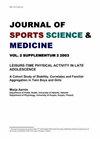世界铁人三项系列赛和奥运会自行车比赛中的功率曲线
IF 2.4
2区 医学
Q2 SPORT SCIENCES
引用次数: 0
摘要
本研究旨在分析世界铁人三项系列赛(WTS)和奥运会中国际级铁人三项运动员在自行车赛段的功率曲线(PP),并评估赛道类型、比赛距离(短跑或奥运距离)和比赛动态对自行车赛段的发展和最终比赛名次的影响。四名男子铁人三项运动员参加了研究。研究人员利用地理定位技术和功率计数据对 20 场比赛进行了分析,以分析PP、比赛动态和赛道特征。赛前,进行了带有气体分析的意志耗竭增量测试,以确定功率强度区。进行了非参数曼-惠特尼 U 检验和相关分析,以确定各种变量之间的差异和关系。观察到超过最大有氧功率(MAP)的时间与每公里危险曲线(r = 0.46;p < 0.05)和自行车分速结果(BSR)(r = -0.50;p < 0.05)之间存在相关性。此外,还发现 BSR 与最终比赛名次之间存在中度相关性(r = 0.46;p < 0.01)。短跑和奥林匹克长跑比赛在任何变量上都没有发现差异。在国际短距离比赛中,受技术赛段影响的功率输出变异性仍是主要特征。本研究结果表明,更适应间歇性高强度努力的铁人三项运动员在国际高水平比赛中的自行车腿表现更好。本文章由计算机程序翻译,如有差异,请以英文原文为准。
Power Profile during Cycling in World Triathlon Series and Olympic Games
This study aimed to analyze the power profile (PP) during the cycling segment of international-level triathletes in the World Triathlon Series (WTS) and Olympics and to evaluate the influence of circuit type, race distance (Sprint or Olympic distance) and race dynamics on the development of the cycling leg and the final race position. Four male triathletes participated in the study. Twenty races were analyzed using geolocation technology and power-meter data to analyze PP, race dynamics, and course characteristics. Before the races, incremental tests of volitional exhaustion with gas analysis were performed to determine power intensity zones. Nonparametric Mann-Whitney U tests and correlation analyses were conducted to identify differences and relationships between various variables. A correlation between the time spent above maximal aerobic power (MAP) and dangerous curves per kilometer (r = 0.46; p < 0.05) and bike split result (BSR) (r = -0.50; p < 0.05) was observed. Also, moderate correlation was found between BSR and the final race position (r = 0.46; p < 0.01). No differences were found between sprint and Olympic distance races in any variable. Power output variability, influenced by technical circuit segments, remains the main characteristic in international short-distance races. The results of the present study suggest that the triathletes who are better adapted to intermittent high intensity efforts perform better cycling legs at international high-level races.
求助全文
通过发布文献求助,成功后即可免费获取论文全文。
去求助
来源期刊
CiteScore
5.60
自引率
6.20%
发文量
56
审稿时长
4-8 weeks
期刊介绍:
The Journal of Sports Science and Medicine (JSSM) is a non-profit making scientific electronic journal, publishing research and review articles, together with case studies, in the fields of sports medicine and the exercise sciences. JSSM is published quarterly in March, June, September and December. JSSM also publishes editorials, a "letter to the editor" section, abstracts from international and national congresses, panel meetings, conferences and symposia, and can function as an open discussion forum on significant issues of current interest.

 求助内容:
求助内容: 应助结果提醒方式:
应助结果提醒方式:


